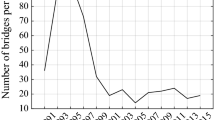We consider domestic and foreign standards for rolled metals used in bridge building. Domestic standards contain elevated requirements to the reliability of rolled metals in terms of their fracture resistance by delamination. Foreign standards admit the application of rolled metals in broader strength ranges but do not contain obligatory requirements imposed on Z-properties and the necessity of monitoring of possible delaminations. Due to the obligatory control of reliability, bridge steels of domestic production are also extensively used in the construction of special building structures.







Similar content being viewed by others
References
V. S. Mes’kin, Foundations of Alloying of Steels [in Russian], Metallurgizdat, Moscow (1954).
G. I. Vister and G. Terkes, Chern. Met., No. 11, 25 (1967).
S. G. Vedenkin, Corrosion Properties of Metals and Alloys [in Russian], Metallurgizdat, Moscow (1954).
I. M. Leikin, D. A. Litvinenko, and A. V. Rudchenko, Production and Properties of Low-Alloy Steels [in Russian], Metallurgiya, Moscow (1972).
I. F. Pemov and O. V. Nosochenko, “Improvement of the mechanical properties of plate iron in the thickness direction,” Metallurg, No. 11, 49–52 (2003).
I. F. Pemov, Yu. D. Morozov, A. M. Stepashin, et al., “Bridge steels of new generation based on naturally alloyed ores of the Khalilovsk deposit,” Metallurg, No. 6, 36–39 (2004).
P. A. Odesskii and A. V. Kulik, Steel of New Generation in Unique Structures [in Russian], Intermet-Inzhiniring, Moscow (2005).
P. A. Odesskii and I. I. Vedyakov, Steel in Building Metal Structures [in Russian], Metallurgizdat, Moscow (2018).
R. Hubo, F. Hanus, and A. Streisselberger, DAST Report, 20/96/ Bremen (Germany), 35–40 (1996).
V. Tanaka, K. Matsuoka, T. Kasuya, and H. Kawasaki, Nippon Steel Technical Report No. 97, Jan. (2008).
K. Wishimura, K. Matsui, and N. Tsumura, JFE Technical Report No. 5, Mar. (2005).
I. P. Shabalov, Yu. D. Morozov, and A. I. Éfron, Steels for Pipes and Building Structures with Improved Operating Properties [in Russian], Metallurgizdat, Moscow (2003).
A. I. Éfron, Metal Science in “Large-Scale” Metallurgy. Pipe Steels [in Russian], Metallurgizdat, Moscow (2012).
A. Usami, X. Kichira, and T. Kusunoki, Nippon Steel Technical Report No. 97, Jan. (2003.
H. Kichikawa, H. Mijuku, S. Hara, et al., Sumitomo Metals,50, No. 1, 48 (1998).
R. Shmitt and W. Galagher, Mater. Prot.,8, No. 12, 70 (1969).
“Anticorrosion paint-and-lacquer materials of the ‘Raznotsvet,’ LLC,” Dorozh. Stroit., No. 1, 49 (2016).
Author information
Authors and Affiliations
Corresponding author
Additional information
Translated from Metallurg, Vol. 63, No. 9, pp. 50–61, September, 2019.
Rights and permissions
About this article
Cite this article
Morozov, Y.D., Pemov, I.F., Matrosov, M.Y. et al. Steels for Bridge Structures. Metallurgist 63, 933–950 (2020). https://doi.org/10.1007/s11015-020-00911-2
Received:
Published:
Issue Date:
DOI: https://doi.org/10.1007/s11015-020-00911-2




